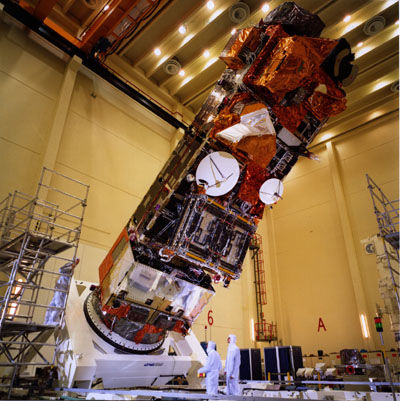
 |
Envisat  Envisat is a truly advanced Earth observing satellite with a unique combination of sensors that will vastly improve the range and accuracy of scientific measurements of the atmosphere, oceans, land surface and ice. Its total range of capabilities far exceeds those of any previous or planned Earth observation satellite. It will be launched in the year 2001 by an Ariane 5. The picture shows integration of the complete Envisat/Polar Platform Flight Model in ESA ESTEC centre.  The ASAR image covers the Antarctic Peninsula, which extends for 1000 km south to north and is situated between the Bellingshausen Sea to the west and the Weddell Sea to the east. This is a region that has experienced exceptional atmospheric warming since the 1950s and is therefore of key interest for global change research. Over the last 50 years an average temperature increase of 2.5°C has been observed at the climate stations on the Peninsula. This has triggered the retreat and break-up of several ice shelves, culminating in the collapse of the two northern parts of the Larsen Ice Shelf in January 1995 (Larsen A) and in March 2002 (Larsen B). The launch of Envisat on 1 March 2002 occurred just in time to capture the dramatic break-up of Larsen B.  The first MERIS observation captured the huge phytoplankton patch produced by the 'upwelling' mechanism along the west coast of Africa near Mauritania. The unprecedented resolution allows fine-scale structures to be detected. In such upwelling areas, northeast trade winds bring deep and nutrient-rich water to the surface, feeding phytoplankton. Changes in climate affect the intensity of the upwelling with important consequences for marine ecosystems, fisheries and local economies. One important task for MERIS is to provide overviews of the dynamics of upwelling areas and their primary production. This, in turn, could improve management of fish stocks within sustainable limits. Another important task for MERIS is to provide information on carbon fixation through photosynthesis within the global ocean for a better understanding of the carbon cycle.
Technical Information: |